Episode 2: Hoi An to Phong Nha
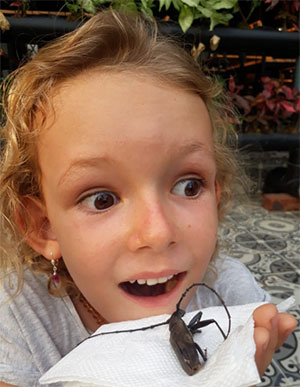 After reluctantly saying goodbye to sister Mirjam, we loaded up the bikes once again and headed inland again for the HCM road, pausing only to pick up a final gourmet sandwich for lunch on the road from the excellent Dingo Deli. The hot plains soon gave way to the foothills of the central highlands, and the riding changed from fairly boring straight roads to the much more interesting twists and turns of the main route north.
After reluctantly saying goodbye to sister Mirjam, we loaded up the bikes once again and headed inland again for the HCM road, pausing only to pick up a final gourmet sandwich for lunch on the road from the excellent Dingo Deli. The hot plains soon gave way to the foothills of the central highlands, and the riding changed from fairly boring straight roads to the much more interesting twists and turns of the main route north.
The road continued up, and up, getting quieter with almost no other traffic, and as we gained altitude the surrounding countryside changed to verdant primary jungle, with giant ferns and palms and vines, with an amazing aroma and absolutely no human activity apart from the occasional army/police outpost - this route runs very close to the Lao border. This road was an absolute joy to ride, bend after bend, always rising, the occasional tunnel through the mountain, but not so interesting for the kids, with not much to entertain them, and the questions of “when are we going to stop dad?” became more frequent. A stop for water and a caramel sucker usually halts the questions for a while...but by late afternoon that day we hadn’t passed anything resembling a cafe or restaurant for hours, and we were out of drinking water. Just before a long tunnel we came upon a police post, and decided to ask the guys there to fill our water bottles. They were friendly and helpful, asking where we were from - we always get a buzz saying that we are from the UK and Switzerland, but the kids are “sinh ra Saigon” (born in Saigon) - and of course the Vietnamese love it. Anyway the boys gave us drinking water - rather smokey it was, probably boiled over a wood fire to purify it - and we headed on, dropping down into a lovely valley - with people and agriculture - and soon got to our destination for that night, a town called A Luoi where we checked into a little Nhà Nghỉ (guesthouse) - and found a beer garden with nice food a couple of doors down, perfect.
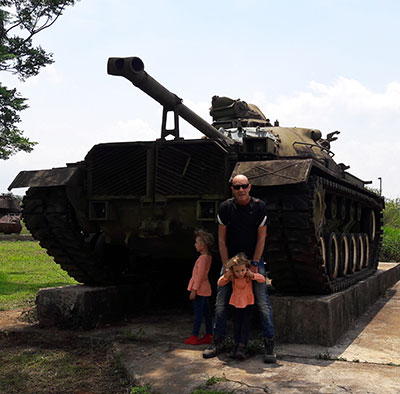 The next morning, with me feeling strangely itchy, we headed onwards towards the town of Khe Sanh, where we lunched on what may have been the greasiest beef soup we’d ever eaten, then decided to check out the Khe Sanh Air Base museum just outside the town. This American airbase saw some fierce fighting between the North Vietnamese and the Americans. These days it is a pretty quiet and peaceful place, with a small museum, a few of the iconic aircraft of the war (Chinook and Huey helicopters, a Hercules transport plane) and a couple of tanks standing around the old runway - there are also some bunkers and trenches that the kids enjoyed running around in.
The next morning, with me feeling strangely itchy, we headed onwards towards the town of Khe Sanh, where we lunched on what may have been the greasiest beef soup we’d ever eaten, then decided to check out the Khe Sanh Air Base museum just outside the town. This American airbase saw some fierce fighting between the North Vietnamese and the Americans. These days it is a pretty quiet and peaceful place, with a small museum, a few of the iconic aircraft of the war (Chinook and Huey helicopters, a Hercules transport plane) and a couple of tanks standing around the old runway - there are also some bunkers and trenches that the kids enjoyed running around in.
We drank an excellent cup of Robusta coffee at the museum cafe, and the kind man running it gave us some information on what he knew about the base and the area. There are now more than 2000 hectares of Robusta coffee growing in the area - he told us that after the war the Vietnamese (later with help of international organisations) had cleared the area of landmines and unexploded bombs - at a big cost in terms of injuries and deaths as part of the process. More than 75,000 tons of bombs had been dropped by B52s on the attacking North Vietnamese Army during the battle of Khe Sanh in 1968 - MAG International have done some great work in mine clearance in Vietnam.
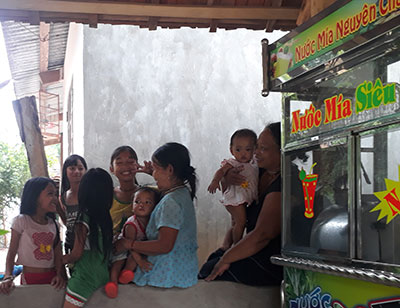 We headed on from the base feeling refreshed, for what would be our longest afternoon on the road to date. The first hour or two I was fielding questions from Marcy about the American war - triggered by what she’d seen at the airbase - and wars in general; thoughtful questions that took a bit of answering in terms that a six year old could understand. And the road again got quieter and quieter, again through the jungle, with more twists, turns, climbs, descents. After a while you find almost a rhythmic meditation...approaching left bend, change down, touch the brakes, position the bike on the right side of the road, lay down the bike to take the curve, on the power as you come through the apex, clutchless change up, power up the hill, change up again, approaching right bend so change down once, twice, touch the brakes, position the bike on the centerline, lay down the bike, take the curve, on the power….rinse and repeat...
We headed on from the base feeling refreshed, for what would be our longest afternoon on the road to date. The first hour or two I was fielding questions from Marcy about the American war - triggered by what she’d seen at the airbase - and wars in general; thoughtful questions that took a bit of answering in terms that a six year old could understand. And the road again got quieter and quieter, again through the jungle, with more twists, turns, climbs, descents. After a while you find almost a rhythmic meditation...approaching left bend, change down, touch the brakes, position the bike on the right side of the road, lay down the bike to take the curve, on the power as you come through the apex, clutchless change up, power up the hill, change up again, approaching right bend so change down once, twice, touch the brakes, position the bike on the centerline, lay down the bike, take the curve, on the power….rinse and repeat...
 The concrete blocks that are a feature of this part of the Ho Chi Minh Duong continued on for us into late afternoon until we finally arrived in Long Son, a one-buffalo town, very light on facilities but in a dramatic position under towering cliffs on all sides. There was a little Nhà Nghỉ for us to stay in, a single restaurant, and a fellow traveller in the form of Greg, an American who was enjoying riding a motorbike all over South East Asia. Beers were drank and stories exchanged, and we established that my “strange itching” in the morning was as a result of bed bugs the night before - I was covered in clusters of bites and was itching like hell. Luckily for us, I was the only one who had used the blanket which was the source of the infestation, so Christina, Marcy and Milly were bite free. Shina takes one for the team.
The concrete blocks that are a feature of this part of the Ho Chi Minh Duong continued on for us into late afternoon until we finally arrived in Long Son, a one-buffalo town, very light on facilities but in a dramatic position under towering cliffs on all sides. There was a little Nhà Nghỉ for us to stay in, a single restaurant, and a fellow traveller in the form of Greg, an American who was enjoying riding a motorbike all over South East Asia. Beers were drank and stories exchanged, and we established that my “strange itching” in the morning was as a result of bed bugs the night before - I was covered in clusters of bites and was itching like hell. Luckily for us, I was the only one who had used the blanket which was the source of the infestation, so Christina, Marcy and Milly were bite free. Shina takes one for the team.
After an incredibly hot night, akin to sleeping in a sauna - the aircon was pretending to work but not actually doing anything, and despite the dramatic mountain scenery we were practically at sea-level now - we headed off grumpily the next morning, but cheered ourselves up with a delicious Bun Bo a few kilometers down the road. I have still to work out the difference between a Bun Bo and a Pho Bo - both have beef, both have noodles - more research required. Anyhow, today was to be a super-short day on the road, it was just 90 minutes before we pulled into our destination and break for the next four days - the wonderful Phong Nha Farmstay, which is the perfect place to stay for exploring the amazing caves and countryside of Phong Nha Ke Bang National Park.
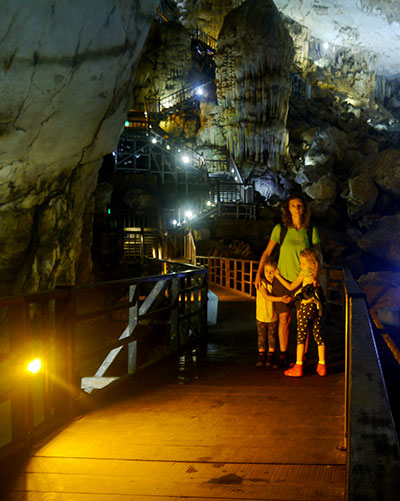 Over the next four days we explored the National Park and local area. We were slightly limited in what we can do because of the kids - you need to be 16+ to do any overnight expeditions into the caves of Tu Lan, Hang En and the biggest cave in the world, Hang Son Doong - but there are still plenty of things to do and see in the park. We took a trip into Paradise Cave (Hang Thien Duong), which is very accessible. We rode the XRs through Phong Nha town and into the dramatic scenery of the park, towering limestone karsts and virgin jungle forests, to the entrance to Paradise. After paying the entrance fee, we walked the 2km to the cave entrance, up through the tropical jungle. Once through the small entrance, we were struck by the scale of this cave - it is truly massive, photos don’t really capture it, up to 70 meters high and 150 meters wide in places - there is room in there to hang an Airbus A380 from the ceiling. There is a descent to the floor of the cave, via a well built wooden staircase, then you can carry on along a boardwalk one kilometer into the depths of the cave, among stunningly beautiful stalagmites rising from the floor of the cave, and stalactites hanging from the roof of the cave way above you, with many of the cave’s features well lit - it is truly a breathtaking experience.
Over the next four days we explored the National Park and local area. We were slightly limited in what we can do because of the kids - you need to be 16+ to do any overnight expeditions into the caves of Tu Lan, Hang En and the biggest cave in the world, Hang Son Doong - but there are still plenty of things to do and see in the park. We took a trip into Paradise Cave (Hang Thien Duong), which is very accessible. We rode the XRs through Phong Nha town and into the dramatic scenery of the park, towering limestone karsts and virgin jungle forests, to the entrance to Paradise. After paying the entrance fee, we walked the 2km to the cave entrance, up through the tropical jungle. Once through the small entrance, we were struck by the scale of this cave - it is truly massive, photos don’t really capture it, up to 70 meters high and 150 meters wide in places - there is room in there to hang an Airbus A380 from the ceiling. There is a descent to the floor of the cave, via a well built wooden staircase, then you can carry on along a boardwalk one kilometer into the depths of the cave, among stunningly beautiful stalagmites rising from the floor of the cave, and stalactites hanging from the roof of the cave way above you, with many of the cave’s features well lit - it is truly a breathtaking experience.
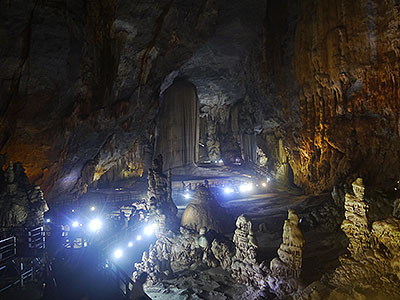 When we reached the end of the boardwalk, we reluctantly turned back for the return journey - it is possible to do another 6km into the depths of this cave, as part of a one day expedition, but this is unlit, and can only be completed as part of an official (escorted) expedition. We will be back to do this one day, when the kids are older.
When we reached the end of the boardwalk, we reluctantly turned back for the return journey - it is possible to do another 6km into the depths of this cave, as part of a one day expedition, but this is unlit, and can only be completed as part of an official (escorted) expedition. We will be back to do this one day, when the kids are older.
The next day we took a trip to Phong Nha cave, which is accessible only by boat, on the Son river. The name of the cave - as well as the town and park - is “wind teeth”. This originates from the stalactites that used to descend from the entrance of the cave - the wind used to whistle through these “teeth”. Unfortunately the teeth were blown off by rockets fired from US warplanes during the American war; the cave was used by the North Vietnamese to store men, munitions and even floating pontoon bridges during the night. These pontoons were taken out each evening after dark, and pulled down the river 6 kilometers, to form a bridge for trucks to cross. Before dawn, the bridge was deconstructed, and taken back to the cave again. The Americans discovered what the north Vietnamese were doing after dropping flares at night and taking reconnaissance photos. They then tried very hard to fire rockets into the cave - not easy as the planes had to fly along the river on the approach to the cave. Apparently it cost them more than ten planes, shot down by the anti-aircraft guns positioned along the river firing down at them, until they managed to get a single rocket into the mouth of the cave. Interestingly, this information was provided by a former American commander who now comes back every year to the area to do charity work with the local community.
The boat trip visiting this cave is fabulous - following the same route up the river, the boats enter the cave and you travel a few hundred meters into the cave, then you’re able to hop out and explore a good section of the interior of the cave yourself on foot, marvel at, and take photos of the beautiful limestone stalactites and stalagmites that have formed over time - remember that it takes about 10 thousand years for one meter to form, so be careful with them...
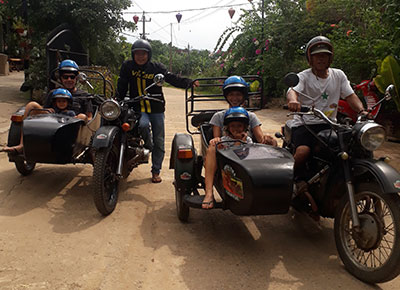 We spent time exploring the countryside surrounding Phong Nha Farmstay by bicycle, and also by Ural motorbike and sidecar - the farmstay offers a free trip in these wonderful old motorcycles that date back to WWII, as well as free bicycles for their guests. We’ve had an amazing time staying at the farmstay, with their great food, swimming pools and super facilities. We were hosted wonderfully by the owners Ben and Bich - and our girls had a lovely time running wild with their two boys Howie and Mike too. We are all sad to leave...but Hanoi and the far north is calling...
We spent time exploring the countryside surrounding Phong Nha Farmstay by bicycle, and also by Ural motorbike and sidecar - the farmstay offers a free trip in these wonderful old motorcycles that date back to WWII, as well as free bicycles for their guests. We’ve had an amazing time staying at the farmstay, with their great food, swimming pools and super facilities. We were hosted wonderfully by the owners Ben and Bich - and our girls had a lovely time running wild with their two boys Howie and Mike too. We are all sad to leave...but Hanoi and the far north is calling...